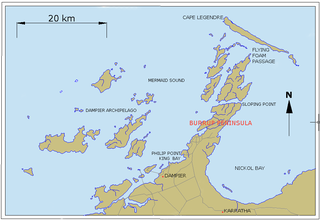
Pilbara Iron is a wholly owned subsidiary of the multinational Rio Tinto Group, that manages assets for Hamersley Iron Pty Ltd, a wholly owned subsidiary of Rio Tinto, and Robe River Iron Associates, an unincorporated joint venture between Rio and three Japanese steel companies Mitsui Iron Ore Development P/L (33%), Nippon Steel Australia P/L (10.5%) and Sumitomo Metal Australia P/L (3.5%).

Dampier is a major industrial port in the Pilbara region in the northwest of Western Australia. It is located near the city of Karratha and Port Walcott.
The Pilbara is a large, dry, thinly populated region in the north of Western Australia. It is known for its Aboriginal peoples; its ancient landscapes; the red earth; and its vast mineral deposits, in particular iron ore. It is also a global biodiversity hotspot for subterranean fauna.

Kumpupintil Lake, formerly known as Lake Disappointment, is an endorheic salt lake located in the Pilbara region of Western Australia.

The night parrot is a small parrot endemic to the continent of Australia. It has also been known as porcupine parrot, nocturnal ground parakeet, midnight cockatoo, solitaire, spinifex parrot and night parakeet. It is one of the most elusive and mysterious birds in the world, with no confirmed sightings of the bird between 1912 and 1979, leading to speculation that it was extinct. Sightings since 1979 have been extremely rare and the bird's population size is unknown, though based on the paucity of records it is thought to number between 50 and 249 mature individuals, and it is classified by the IUCN as an endangered species.

The Electoral district of Pilbara is a Legislative Assembly electorate in the state of Western Australia. Pilbara is named for the region of Western Australia in which it is located. It is one of the oldest electorates in Western Australia, with its first member having been elected to the Second Parliament of the Legislative Assembly at the 1894 elections.

Rory Cooper's false antechinus, also known as the tan false antechinus and the tan pseudantechinus, is a recently named species of small carnivorous marsupial which inhabits rocky outcrops in Western Australia. Nothing is known of its behaviour but it is expected that this will be similar to other members of the false antechinus genus. A study published in 2017 found no support for separation as a new species of Pseudantechinus, and the name was proposed to be synonymous with the previously described Pseudantechinus macdonnellensis.

The Pilbara ningaui, sometimes known as Ealey's ningaui, is a tiny species of marsupial carnivore found in Australia.

The chocolate wattled bat, species Chalinolobus morio, is a bat allied to the family Vespertilionidae. It is found only in Australia, including the island Tasmania, and widespread in southern regions. It is known to reside from sea level to at least 1,570 metres (5,150 ft) in Victoria.
Western pebble-mound mouse or Ngadji, species Pseudomys chapmani, is a burrowing and mound building rodent in the family Muridae. They are occur in the Pilbara, a remote region in the northwest of Australia.
The Pilbara monitor, also known commonly as Bush's monitor, Bush's pygmy monitor, and the Pilbara mulga goanna, is a species of monitor lizard in the family Varanidae. The species is endemic to Australia.
The Yarrie mine is an iron ore mine located in the Pilbara region of Western Australia, 90 kilometres north-east of Marble Bar.
The tiny Pilbara toadlet ) is a species of frog in the family Myobatrachidae. It is endemic to the arid Pilbara region of Australia. It is a burrowing frog and is found in rocky gorges and creeks in the Pilbara following cyclonic rains. The species name saxatilis means "rock-dwelling".
Main Roads Western Australia controls the major roads in the state's Pilbara region. There are two main highways in the region: Great Northern Highway, which travels north through the region to Port Hedland and then north-west along the coast, as well as North West Coastal Highway, which heads south-west from Port Hedland. A series of main roads connects towns to the highways, and local roads provide additional links. The majority of these roads service the western half of the region, with few located in the various deserts east of the Oakover River. Roads are often named after the towns or areas they connect.

The Pilbara Coast is the coastline of Western Australia's Pilbara region. It is often referred to as the North West Coast of Western Australia.

Nososticta pilbara is a species of Australian damselfly in the family Platycnemididae, commonly known as a Pilbara threadtail. It has only been found in the Pilbara region of Western Australia, where it inhabits streams and pools.
Pilbara Minerals is an Australian lithium and tantalite mining company.
Malcolm Eric Trudgen is a West Australian botanist. He has published some 105 botanical names. He currently runs his own consulting company, ME Trudgen and Associates.
Areacandona is a genus of ostracods belonging to the family Candonidae.
Grevillea saxicola is a species of plant in the protea family that is endemic to Australia. The specific epithet saxicola refers to the species’ habitat.









